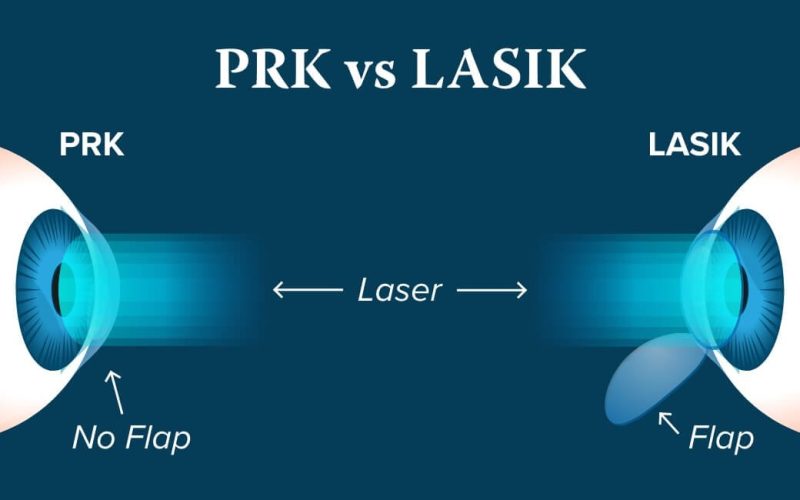Introduction
If you wear glasses or contact lenses, you’ve probably wondered about vision correction surgery. Two of the most popular procedures are PRK (Photorefractive Keratectomy) and LASIK (Laser-Assisted In Situ Keratomileusis). Both are safe, FDA-approved treatments that correct vision problems like nearsightedness, farsightedness, and astigmatism. However, they have some key differences in terms of recovery time, procedure steps, and who they’re best for.
Choosing between PRK and LASIK can be a little confusing, especially if you’re hearing about these terms for the first time. This article will help you understand how each procedure works, what benefits and risks they offer, and how to decide which is right for you.
What Is PRK?
PRK is a type of laser eye surgery that reshapes the cornea to improve vision. It was the first laser vision correction procedure approved by the FDA and is still used today, especially for patients with thinner corneas.
In PRK, the surgeon removes the outermost layer of the cornea, called the epithelium. Then, a laser is used to reshape the underlying corneal tissue. Over the next few days, the epithelium grows back naturally. While this makes recovery longer than LASIK, PRK is considered a better option for some individuals due to safety concerns related to corneal thickness.
What Is LASIK?
LASIK is the most well-known laser eye surgery. It also reshapes the cornea to correct vision, but the method is different. In LASIK, the surgeon creates a thin flap in the cornea using a microkeratome or laser. The flap is lifted, and a laser reshapes the inner corneal tissue. The flap is then placed back and acts like a natural bandage.
This flap-based technique allows for a quicker recovery, and most patients see clearly within 24 to 48 hours. LASIK is preferred by many because of its fast healing and minimal discomfort.
Key Differences Between PRK and LASIK
Understanding the major differences between PRK and LASIK can help you decide which one fits your needs better. Here are the most important aspects:
1. Procedure Method
- PRK: Removes the corneal epithelium completely and uses a laser to reshape the cornea.
- LASIK: Creates a flap in the cornea, reshapes the tissue underneath, and replaces the flap.
2. Recovery Time
- PRK: Longer recovery (about 1–2 weeks for clear vision and several weeks for complete healing).
- LASIK: Shorter recovery (most patients see clearly within 1–2 days).
3. Discomfort After Surgery
- PRK: More discomfort due to the removal of the corneal surface.
- LASIK: Less discomfort due to flap-based healing.
4. Suitability
- PRK: Suitable for people with thin corneas, active lifestyles, or those at risk of eye injuries (e.g., athletes, military personnel).
- LASIK: Better for those with average corneal thickness and low risk of physical trauma to the eyes.
5. Long-Term Results
Both procedures offer similar long-term results in terms of vision correction. Many patients achieve 20/20 vision or better with either PRK or LASIK.
Who Is a Better Candidate for PRK?
PRK is ideal for individuals who:
- Have thin or irregular corneas
- Have jobs or hobbies that involve physical contact or risk of injury (e.g., sports, military)
- Have dry eyes or other corneal surface issues
- Are not suitable for LASIK due to corneal thickness
Because PRK doesn’t involve creating a flap, there’s less risk of complications related to flap dislocation. This makes it a safer option for people who are more active or might get hit in the face or eyes.
Who Is a Better Candidate for LASIK?
LASIK is a great option for those who:
- Want faster recovery and minimal discomfort
- Have a healthy corneal thickness
- Don’t have severe dry eye issues
- Prefer to return to work or daily activities quickly
If your lifestyle is mostly indoors or you have a desk job, LASIK offers a more convenient healing period and faster visual improvement.
Possible Side Effects and Risks
While both procedures are considered safe, it’s important to be aware of the potential side effects and risks:
Common Side Effects for PRK and LASIK:
- Dry eyes
- Halos or glare at night
- Sensitivity to light
- Blurry vision during recovery
Rare Complications:
- Infection
- Under or over-correction
- Corneal haze (more common in PRK)
Most side effects are temporary and can be managed with eye drops and follow-up care. Your eye surgeon will explain all possible risks during your consultation.
Cost Comparison
The cost of PRK and LASIK can vary depending on the clinic, location, and surgeon’s experience. Generally, the cost for both procedures is quite similar, ranging between $1,500 to $3,000 per eye.
Some clinics may offer payment plans or financing options to make the surgery more affordable. It’s important to remember that cheaper isn’t always better. Look for qualified surgeons and read reviews before making a decision.
What to Expect After Surgery
Whether you choose PRK or LASIK, here’s what your post-surgery experience might look like:
For PRK:
- Blurry vision for the first few days
- More discomfort and longer time off work
- Vision improves gradually over 1–4 weeks
- Avoid rubbing your eyes and follow all post-care instructions
For LASIK:
- Clear vision within 24–48 hours
- Mild dryness or irritation for a few days
- Avoid makeup, pools, or dusty environments for a short time
- Resume most daily activities within 2–3 days
Regular follow-up visits are essential to make sure your eyes are healing properly.
Making the Right Choice
Choosing between PRK and LASIK depends on several factors—your eye structure, your lifestyle, and your expectations. There’s no one-size-fits-all answer. A consultation with an experienced eye surgeon is the best way to determine which option is safer and more effective for you.
Ask the following questions during your consultation:
- What is the thickness of my cornea?
- Do I have any risk factors for complications?
- How will the procedure affect my lifestyle or profession?
- What are the long-term results likely to be?
Conclusion
Both PRK and LASIK are excellent choices for correcting vision and reducing the need for glasses or contacts. PRK may involve a longer recovery and more initial discomfort but offers safety advantages for certain individuals. LASIK provides quicker results and less downtime, making it ideal for those seeking a fast return to normal activities.
Your eye health, lifestyle, and comfort level with recovery will help guide your choice. Make sure to consult with a trusted eye surgeon, follow all pre- and post-surgery instructions, and choose the option that supports your long-term vision goals. With the right care, you can enjoy clearer vision and improved quality of life.












